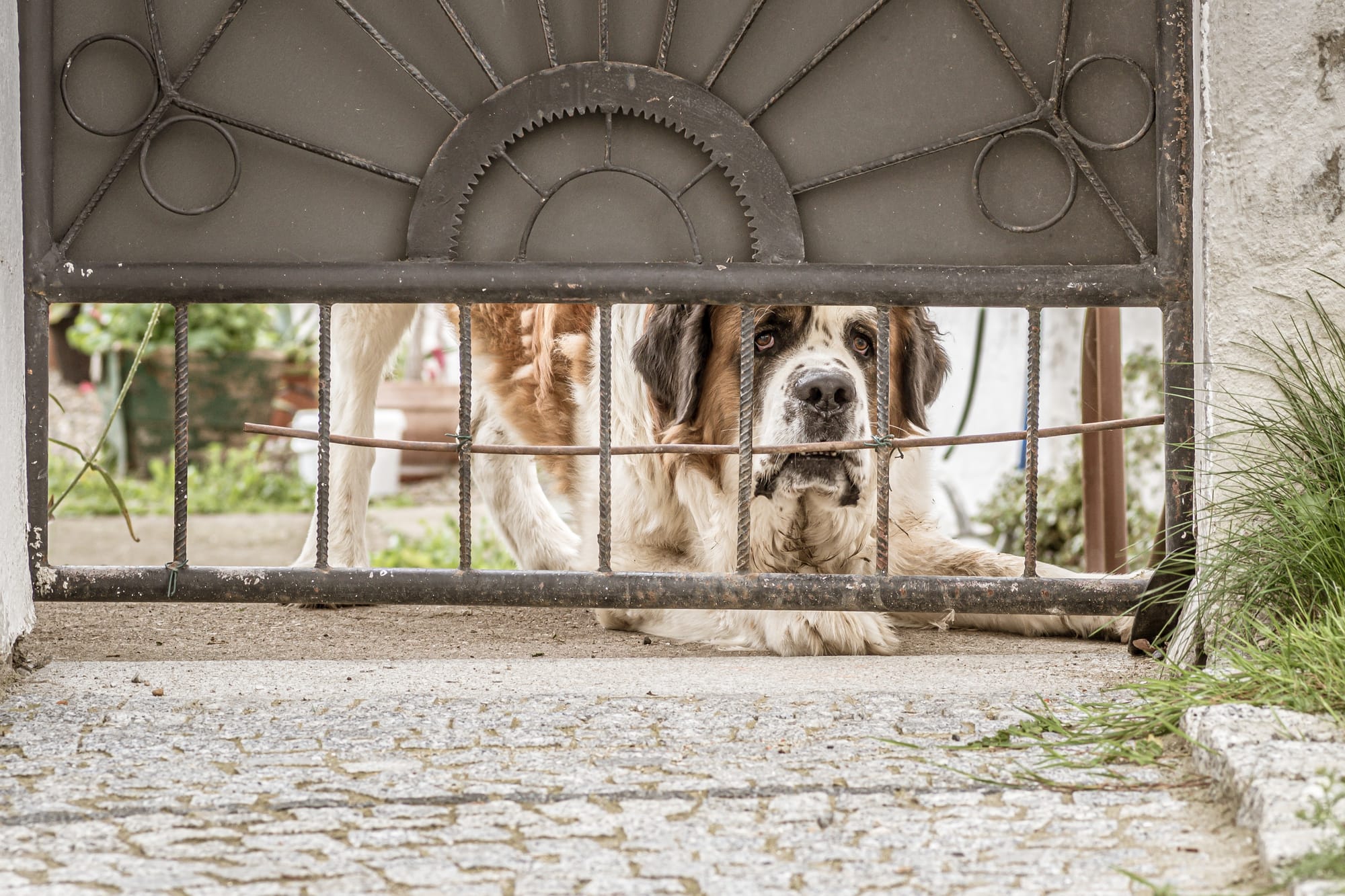When envisioning a St. Bernard, one might imagine a gentle giant, with its imposing size juxtaposed against a backdrop of benevolent eyes and a demeanor as soft as its thick, inviting fur. Renowned historically for their heroic rescues in the Swiss Alps, these colossal canines have carved out a niche in popular imagination as the epitome of the gentle, loyal companion. Yet, as with many large breeds, St. Bernards are not immune to the stereotypes that often cast a shadow of aggression over their colossal frames.

This article delves into the heart of these misconceptions, aiming to unravel the threads of truth behind the St. Bernard's temperament. For first-time owners and curious minds alike, we embark on a journey to dissect the myth of aggression surrounding these majestic creatures, offering insights and guidance to forge a harmonious bond with one of the most affectionate giants of the canine world.
The St. Bernard: Breed Overview
The St. Bernard breed, a symbol of courage and dedication, traces its noble lineage back to the Great St Bernard Pass in the Swiss Alps, where monks established a hospice in the 11th century. Originally bred to assist in rescue operations for lost or injured travelers, these dogs quickly became renowned for their remarkable sense of direction and resilience in harsh conditions. With their imposing stature, St. Bernards can stand up to 30 inches at the shoulder and weigh as much as 180 pounds, embodying a powerful yet gentle presence.
Characterized by a dense, weather-resistant coat, often in striking shades of red and white, and a visage marked by expressive, kind eyes, these dogs exude a natural warmth and amiability. Their temperament is as vast as their size; despite their formidable appearance, St. Bernards are known for their tranquil and affectionate nature, making them excellent family pets and companions.
In popular culture, St. Bernards have been immortalized as the quintessential rescue dog, most famously epitomized by Barry, a legendary canine who saved over 40 lives in the early 1800s. Their depiction in media, from the whimsical Beethoven film series to the heartwarming tales in children's literature, has further cemented their status as gentle giants, endearing them to audiences worldwide and solidifying their role as not just pets, but heroes in both history and heart.
Understanding Dog Aggression
Understanding aggression in dogs is pivotal to nurturing a safe and harmonious relationship between pets and their human companions. Aggression manifests through various behaviors, from growling and snarling to snapping and outright biting. These actions, often misunderstood, are typically a dog's response to what it perceives as threats to its safety, territory, or pack hierarchy. It's a complex behavior influenced by a multitude of factors, including genetics, socialization experiences, training, environment, and sometimes, health issues.
Across breeds, common triggers for aggression include fear, a desire to establish dominance, protection of resources (such as food or toys), and a natural instinct to defend their human family or territory. It's crucial to distinguish between aggression and protective behavior; the latter is a dog's instinct to guard its loved ones or home from perceived threats and is generally more controlled and context-specific. Aggression, in contrast, can be unpredictable and disproportionate to the perceived threat.
Understanding these nuances is essential for addressing and managing aggressive tendencies effectively. Recognizing the signs and triggers can help pet owners and trainers create interventions that foster safety and well-being for both dogs and their human families.

St. Bernards and Temperament
The temperament of a St. Bernard is a tapestry woven with threads of gentleness, patience, and loyalty, characteristics that define this breed's intrinsic nature. Known for their calm and friendly demeanor, St. Bernards embody a serene disposition that belies their massive stature. Their tendency towards a peaceful, amiable personality makes them exceptional companions, particularly in families with children, where their protective instincts manifest through care rather than aggression.
Genetics play a pivotal role in shaping the temperament of St. Bernards. Historically bred for rescue and companionship, these dogs have been selected over generations for traits that enhance their ability to work closely with humans under stressful conditions. This selective breeding has fostered an innate predisposition towards human-friendly behaviors, reducing tendencies towards unnecessary aggression. The genetic makeup of St. Bernards inclines them to be more tolerant and less prone to the territorial aggression seen in some other breeds.
Breed experts and behavioral studies corroborate the gentle nature of St. Bernards, often highlighting their exceptional patience and tolerance. Research indicates that while St. Bernards, like any large breed, require proper training and socialization to harness their best qualities, they inherently possess a foundation of calmness and affection. Experts emphasize the importance of understanding the breed's needs for companionship and activity, advocating for consistent, positive reinforcement training methods that align with their responsive and sensitive character.
Behavioral studies also shed light on the St. Bernard's capacity for empathy, suggesting that their historical role as rescue dogs has imbued the breed with a unique sensitivity to human emotions. This empathetic streak further tempers any aggressive tendencies, steering their behavior towards nurturing rather than dominance.
The St. Bernard's temperament is a reflection of centuries of careful breeding, aimed at cultivating a gentle giant well-suited to the roles of both rescuer and companion. Their genetic legacy, combined with insights from breed experts and behavioral research, paints a picture of a breed whose aggression is the exception, not the rule, predicated more on protective love than on inherent hostility.

Factors That Influence Aggression in St. Bernards
The manifestation of aggression in St. Bernards, as with any breed, is influenced by a confluence of environmental and biological factors. Understanding these elements is crucial for mitigating risks and fostering a harmonious relationship between these gentle giants and their human companions.
Environmental Factors:
Training and socialization are cornerstone practices that significantly shape a dog's behavior. St. Bernards, with their intelligent and eager-to-please nature, respond well to positive reinforcement and early socialization. Exposing them to various people, environments, and other animals from a young age helps in developing a well-adjusted temperament, reducing fear-based aggressive responses. The living conditions also play a pivotal role; St. Bernards thrive in environments where they feel part of the family, with ample space to move and regular mental and physical stimulation to prevent boredom and frustration, which can lead to destructive behaviors.
Biological Factors:
Health issues can inadvertently lead to aggression in St. Bernards. Conditions such as hip dysplasia, common in larger breeds, can cause pain and discomfort, potentially leading to irritability and aggression. Moreover, genetic predispositions can influence temperament, making the selection of reputable breeders who prioritize the health and demeanor of their breeding stock essential.
Impact of Neutering/Spaying:
Neutering or spaying can have a notable impact on aggression in dogs. These procedures can reduce the levels of certain hormones in the body, such as testosterone, which is associated with aggressive behavior in males. While the effects can vary, neutering/spaying is generally seen as a positive step towards mitigating aggressive tendencies, particularly those related to territorial or mating behaviors, thereby promoting a more placid temperament.
While St. Bernards are predisposed to a gentle and friendly demeanor, their environment, health status, and biological factors can influence the expression of aggression. Understanding and managing these aspects are key to nurturing their inherent benevolence, ensuring these majestic dogs live up to their reputation as affectionate companions rather than aggressive protectors.

Training and Socialization Techniques
Early and consistent training, coupled with thorough socialization, are indispensable elements in the upbringing of a St. Bernard, ensuring they mature into well-mannered and sociable adults. Given their colossal size and strength, instilling good behavior from a young age is crucial not just for the dog's well-being, but for the safety and harmony of its human and animal companions.
Early and Consistent Training:
The axiom "start early" cannot be overstated when it comes to training St. Bernards. These dogs are quick learners, but their large size can make them difficult to manage if basic commands are not instilled early. Utilizing positive reinforcement techniques such as treats, praise, and play, fosters a love for learning and obedience in St. Bernards. Consistency in commands, rewards, and boundaries is key to reinforcing desired behaviors. Regular, short training sessions help in maintaining their attention and interest, making learning a positive experience.
Socialization with Other Pets and Humans:
Socialization should begin in puppyhood, exposing them to a variety of people, animals, environments, and situations. This exposure helps in developing a well-rounded character, reducing fear and anxiety in new situations, and minimizing aggression. Friendly interactions with other dogs and pets, under supervised conditions, teach St. Bernards appropriate social behaviors, helping them understand play cues and boundaries. Introducing them to different types of people — children, elderly, people wearing hats or uniforms — can prevent a fear-based aggressive response in unfamiliar situations.
Addressing Aggressive Tendencies:
Should aggressive tendencies surface, it's imperative to address them promptly. Understanding the root cause is essential — whether it's fear, pain, or protective instinct — and responding with appropriate training and possibly consultation with a professional dog behaviorist. Redirecting negative behaviors through positive reinforcement and avoiding punishment that can instigate fear or aggression is crucial. Ensuring St. Bernards feel secure, loved, and part of the family unit can significantly diminish the likelihood of aggressive behaviors developing.
Training and socializing a St. Bernard requires patience, consistency, and understanding, but the reward is a loyal, gentle, and friendly companion that embodies the best qualities of this magnificent breed.

Creating a Safe and Stimulating Environment
Designing a living space for a St. Bernard involves accommodating their size and energy levels to create a safe and stimulating environment. These gentle giants require ample room to move and rest comfortably, so spacious indoor areas with easy access to a securely fenced outdoor space are ideal. Ensuring their living quarters are free from hazards that can cause injury or stress, such as small, fragile objects they might accidentally break, is also crucial.
Mental and physical stimulation play a key role in preventing aggression and other undesirable behaviors in St. Bernards. Regular exercise tailored to their size and endurance, such as leisurely walks and play sessions in a large, safe area, helps in expending energy positively and maintaining their health. Mental stimulation can be provided through interactive toys, puzzle feeders, and training sessions that challenge their intellect and keep boredom at bay.
Appropriate toys for St. Bernards should be durable and size-appropriate to withstand their powerful jaws and large stature. Chew toys, large balls, and tug ropes can provide both physical exercise and mental engagement. Activities that involve human interaction, like gentle play, training exercises, and companionship, fulfill their social needs, fostering a well-rounded and contented demeanor that mitigates aggressive tendencies.
Health Issues and Behavioral Links
St. Bernards, like any large breed dog, are susceptible to specific health issues that can influence their behavior. Hip and elbow dysplasia are common in larger breeds and can lead to discomfort and pain, potentially causing irritability or aggression in a normally docile dog. Moreover, conditions such as bloat (gastric torsion) and heart problems are also prevalent, which can affect their energy levels and temperament.
Preventative measures are key to mitigating these health risks and their behavioral repercussions. Regular veterinary check-ups are essential to early detection and management of potential health issues. A well-balanced diet tailored to their size, age, and activity level helps in maintaining optimal weight, reducing the strain on joints and minimizing the risk of bloat. Adequate exercise is crucial for physical health, but it's important to balance activity levels to avoid exacerbating potential joint problems.
Mental well-being is equally important; consistent training, social interaction, and mental stimulation can prevent stress and anxiety, which can lead to behavioral issues. Providing a stable, loving environment and routine can also help in maintaining a calm and balanced demeanor in St. Bernards, ensuring their physical and emotional health are both well cared for.
Tips for Prospective and First-Time St. Bernard Owners
Prospective and first-time St. Bernard owners must weigh several considerations before welcoming these gentle giants into their homes. Acknowledging the reality of living with a large breed dog is paramount, as St. Bernards require significant space both indoors and outdoors to move comfortably and rest. Their size also necessitates a commitment to managing their physical needs, from ensuring they have a suitable diet to accommodate their large frame to regular veterinary care for breed-specific health concerns.
The financial aspect is another critical consideration. Owning a St. Bernard involves considerable costs, including high-quality food in large quantities, healthcare, grooming supplies, and potential home modifications to accommodate their size.
Moreover, St. Bernards thrive on companionship and require ample time with their family, making them less suited to households where they would be left alone for extended periods. Their training and socialization are ongoing commitments that demand time and patience, ensuring they grow into well-behaved and social members of the community.
Embracing a St. Bernard into your life is a long-term commitment, often lasting a decade or more. Prospective owners must be prepared for the responsibilities of large breed ownership, ensuring they can provide a loving, stable, and stimulating environment for their new companion.
Conclusion
In exploring the nature of St. Bernards, we've delved into their gentle disposition, debunking myths of aggression while highlighting the importance of proper training, socialization, and care. These majestic dogs, known for their historical role as rescuers, exhibit a benevolence that is ingrained in their genetics, further nurtured through responsible ownership. Potential and current owners are encouraged to embrace the commitment that comes with a St. Bernard, fostering their inherent gentle giant persona through understanding, patience, and love. Embodying both strength and tenderness, St. Bernards stand as a testament to the profound bond between humans and their canine companions, enriching lives with their unwavering loyalty and affection.

FAQs
- Are St. Bernards good family pets?
- St. Bernards are known for their gentle and friendly nature, making them excellent family pets. They are particularly patient and tolerant with children.
- How much exercise does a St. Bernard need?
- Despite their size, St. Bernards do not require excessive exercise. Daily walks and playtime are sufficient to keep them healthy and happy.
- Do St. Bernards require a lot of space?
- Given their large size, St. Bernards do best in homes with ample space both indoors and outdoors. They can adapt to smaller spaces if provided with regular exercise.
- Are St. Bernards prone to any specific health issues?
- St. Bernards are susceptible to certain health conditions such as hip dysplasia, bloat, and heart problems. Regular veterinary check-ups and a healthy lifestyle are important.
- How do I train and socialize a St. Bernard?
- Early, consistent training and socialization are crucial. Positive reinforcement methods work well, and exposing them to various environments, people, and other animals from a young age is beneficial.
- Can St. Bernards be aggressive?
- St. Bernards are generally not aggressive and are known for their gentle demeanor. However, like any dog, improper training, lack of socialization, or health issues can lead to aggressive behavior.
- What is the lifespan of a St. Bernard?
- St. Bernards typically live between 8 to 10 years. Providing a healthy diet, regular exercise, and preventive healthcare can contribute to a quality life.
- How much grooming do St. Bernards need?
- St. Bernards have dense, water-resistant coats that require regular grooming. Brushing a few times a week and occasional baths help manage shedding and maintain coat health.
- Is it expensive to own a St. Bernard?
- The cost of owning a St. Bernard can be higher than smaller breeds due to food consumption, healthcare, and potential home adjustments to accommodate their size.
- Are St. Bernards easy to train?
- St. Bernards are intelligent and eager to please, making them relatively easy to train with the right approach. Patience and consistency are key.




